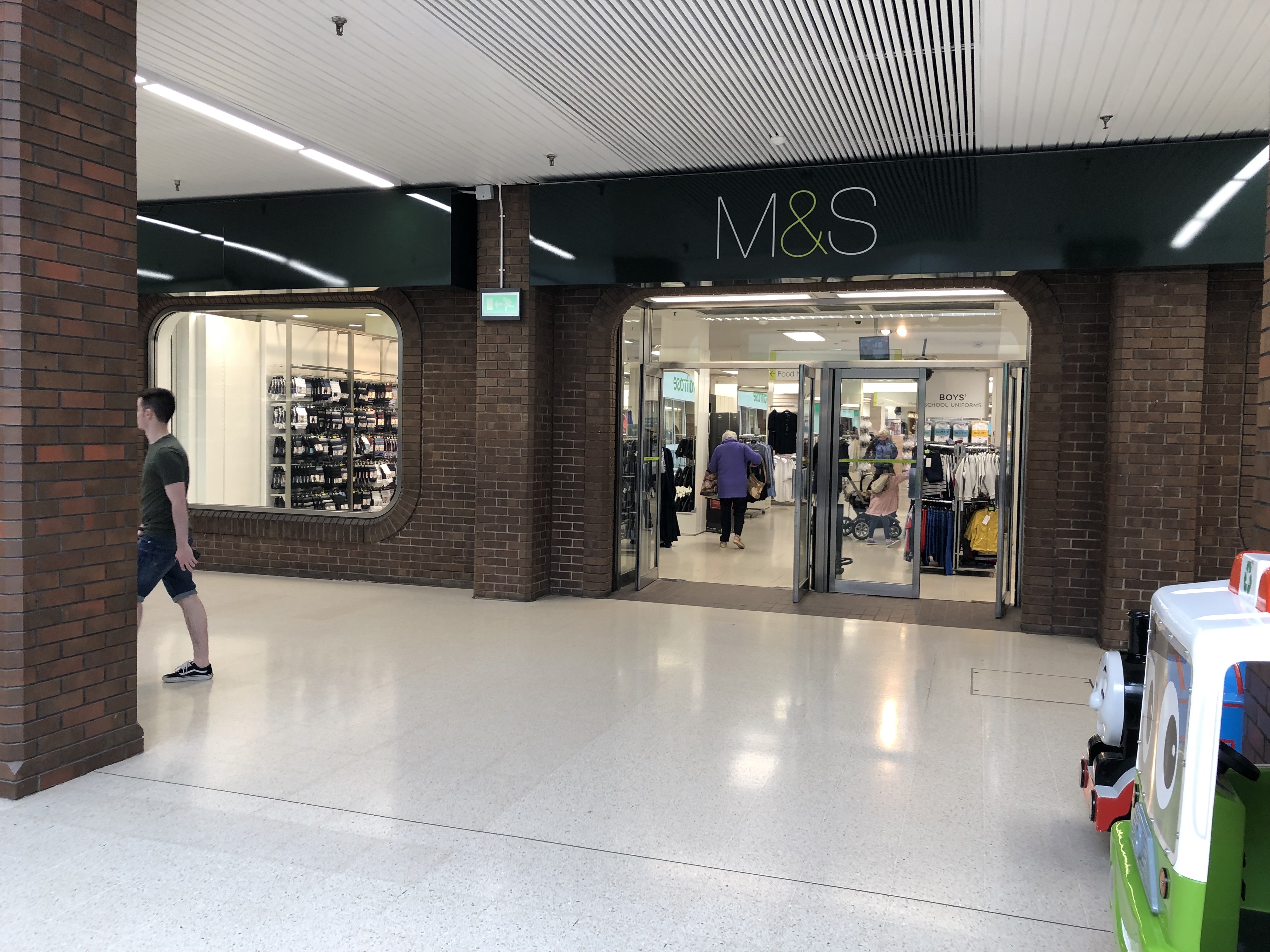Staff and shoppers said an emotional goodbye to Marks and Spencers in Buxton on Saturday 27th April, as the store closed its doors for the final time.
Shelves were left empty as 85 years of history for the store in Buxton came to a sad end. M&S announced in January that Buxton was one of another 17 branches on its closure list, following other closures across the country in recent years including nearby Stockport which closed in 2018.
Following the shock announcement, an online petition was launched in a bid to ‘save’ the Buxton store, which attracted more than 4,000 signatures. High Peak MP Ruth George was quickly on the case and initially wrote to M&S and then met with store managers to ask them to reconsider the closure plan for Buxton. Of the closure plans she said:
“The M&S store is an important anchor on Buxton’s high street, not least because we live in a rural area.
“I know many people, especially older residents (who do not always have access to the internet) rely on the store for clothes shopping; as do young families; especially now that M&S has closed its stores in Stockport and Denton.”
“When I met with the company to press the case for Buxton, they were obviously more interested in saving costs in the short term by closing the store than in long term investment. This is obviously a great blow for Buxton town centre, for loyal customers of M&S, and especially for the excellent and close-knit team of staff at the store.”
Loyal customers visited the store for the final on Saturday and by late morning much of the Food Hall was just empty shelves – with all food reduced to half price or less and by 3.30pm the store was closed. “It’s a really sad day. I don’t know what’s going to to happen to Buxton shops, I worry about that a lot. I’ve been shopping in ‘Marks’ for years, I’ll really miss the food hall”, said one shopper outside.
The store – which has entrances in both Spring Gardens and inside The Springs Shopping Centre was a busy and well used thoroughfare in Buxton. “I wanted one last walk through – but it’s too late, its closed”, said another shopper outside the store, who was visibly upset.
Another shopper leaving the store said, “Ive just been in and everything is half price and I’ve bought a huge amount while I can. I don’t really want to have to travel to Macclesfield, so I just don’t think I will shop in M&S as much, it’s the Food Hall I will miss but the underwear is also excellent. What we need to is to make the high street more of an experience for visitors, I think there’s hope with all the regeneration in Buxton at the moment with the Crescent and the Gardens (Pavilion Gardens) so we just have to look forward now and hope the unit is taken by a retailer that will serve us well. If Waitrose closes, I’m leaving town!”.
A branch of Marks and Spencers is still a badge of pride for high streets around the country – often one of the biggest and best-sited stores in town, as was the case with Buxton. But the rise of online shopping and cheaper rivals like Primark that appeal to younger shoppers means M&S is facing an existential threat with many more stores planned for closure as part of a reinvention plan.
A history dating back 135 years
The company was originally formed in 1884 by Polish refugee Michael Marks who opened a penny bazaar on Kirkgate Market in Leeds. Whilst looking for work, he met Issac Jowitt Dewhirst who lent him £5 which he used to establish his stall. Dewhirst also taught him some English. Marks then met Thomas Spencer – a former cashier from the wholesale company IJ Dewhirst and their partnership began in 1894 which saw the business grow quickly. In 1901 a new warehouse and head office opened in Manchester. The next few years saw Michael Marks and Tom Spencer open market stalls in many locations around the North West of England and in the early 20th century Marks and Spencer known colloquially as “Marks and Sparks” or “M&S” made its reputation in the early 20th century with a policy of only selling British-made goods (it started to back down from this policy in the 1990s.)

The well loved brand St. Michael (honouring Michael Marks) was introduced in 1928, selling food and clothes under the label. It also accepted the return of unwanted items, giving a full cash refund if the receipt was shown, no matter how long ago the product was purchased, which was unusual for the time.
They sold their first bra in 1926…
In 1930, M&S opened its flagship store at Marble Arch, London and a year later they opened a food department selling fresh produce and canned goods.
By 1950, virtually all goods were sold under the St Michael label. M&S lingerie, women’s clothes and girls’ school uniform were branded under the St Margaret label until the whole range of general merchandise became St Michael. The uncompromising attitude towards customer relations was summarised by the 1953 slogan: “The customer is always and completely right!”
The company put its main emphasis on quality, including a 1957 stocking size measuring system. For most of its history, it also had a reputation for offering fair value for money. When this reputation began to waver, it encountered serious difficulties. Arguably, M&S has historically been an iconic retailer of ‘British Quality Goods’.
M&S began selling Christmas cakes and Christmas puddings in 1958. In an effort to improve the quality of their Swiss rolls, they hired the food expert Nat Goldberg, who made a major improvement across their entire cake range, which had lost the public’s favour a few years earlier. As a later measure to improve food quality, food labelling was improved and “sell by dates” were phased in between 1970 and 1972.
Smoking was banned from all M&S shops in 1959 because of the fire hazards it posed.
Energy efficiency was improved by the addition of thermostatically controlled refrigerators in 1963. In the 1970s it still sourced most of its products from the UK – unlike now when they are mostly made internationally. In 1975 they opened stores in continental Europe and in Ireland four years later.
In 1972, Marcus Sieff became chairman, remaining in place until 1984, and emphasising the importance of good staff relations to the tradition of the store, while extending staff benefits to areas such as restaurants and chiropody.
Sir Richard Greenbury ruled M&S through the 1990s, and in 1998 it became the first British retailer to make pre-tax profits of over £1bn. It took a decade until it achieved this again. But Greenbury’s reign ended with bitter boardroom infighting.
1999 saw the company launch their online shopping via their website.
In 2000, in the middle of a sales slide, M&S faced customer complaints over its back-to-basics ad campaign featuring size 16 ‘real women’ in the buff. It was eventually ditched.
With the popularity of the Food Halls firmly continuing, they opened their first Simply Food stores in 2001 in Surbiton and Twickenham. The Per Una range was also launched the same year.
In February 2007, M&S announced the opening of the world’s largest M&S shop outside the UK at Dubai Festival City. Ad campaigns starring Myleene Klass, Twiggy, Jagger and Noemie Lenoir have been credited with reviving clothes sales.
M&S are drawing on its vast history more and this is shown with its new logo introduced in 2015 with EST 1884. The company continues to face challenges and has started to restructure to make sure the business is fit for the next 135 years – which as we’ve seen, includes stores closures, many in smaller towns with smaller branches.
In 2016 the company announced its new CEO Steve Rowe, currently Head of Clothing, and previously Head of Food.
Growing to over 979 stores, the modern M&S is a truly international business with 450 stores outside the United Kingdom.
Did You Enjoy This?
You might like our regular newsletter. We put all the best events, cultural highlights and offers from Buxton and the Peak District in your inbox every month.
This information will only be used to send you this newsletter. It is stored in Mailchimp.














